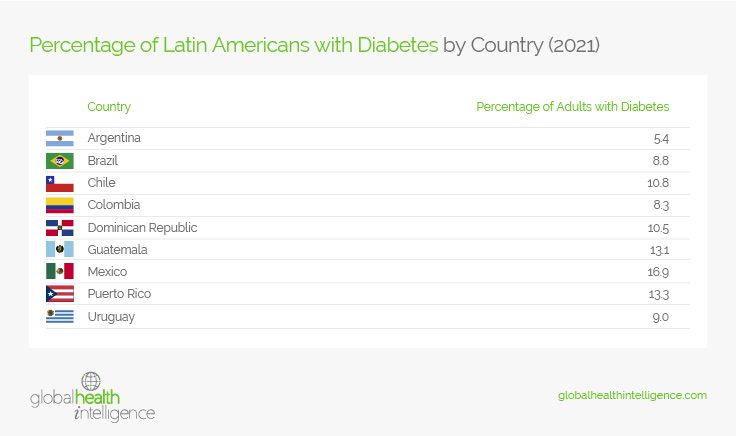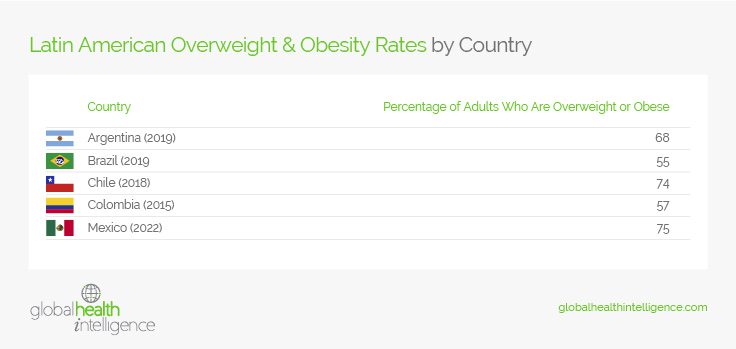How Latin America Is Fighting Chronic Diseases
By Guillaume Corpart
Chronic diseases like heart disease, diabetes and obesity are growing problems around the world, not just in Latin America. But the various nations around the region have their own unique issues with these diseases, and each is experiencing a steady rise as time goes by.
For example, the number of adults with diabetes in Brazil in 2022 was projected around 15 million, with 14 million more in Mexico, and those numbers are only projected to grow larger over time. In Mexico alone, adults have twice the rate of type 2 diabetes as Europeans or white Americans.
Obesity poses similar challenges in Latin America, with recent projections from The Lancet putting the rate of overweight people in the region at 57%, with 19% being obese. This is higher than the global rates of overweight and obesity, which are around 39% and 13%, respectively.
When it comes to heart disease, the news for Latin America is a little better, but there is still work to be done in the region, just as there is around the world. Heart disease remains the number one killer of all people globally and in Latin America. But according to the International Journal of Cardiology, rates in the region actually dropped when standardized by age between 1990 and 2019. High blood pressure, or hypertension, also remains an issue around the region, with 35.4% of adults aged 30-79 affected by the disease.


Initiatives to Fight Chronic Diseases
Luckily, several major medical organizations are aware of the challenges of these chronic health diseases throughout the region and are taking steps to reduce their prevalence. One prime example is the Pan American Health Organization (PAHO), which is moving forward with the WHO Acceleration Plan to Stop Obesity throughout Latin America. The nine countries pioneering this initiative are Argentina, Barbados, Brazil, Chile, Mexico, Panama, Peru, Trinidad and Tobago and Uruguay.
The PAHO plan involves several strategies, including:
- Regulating the marketing of unhealthy food products
- Applying front-of-package warning labels to unhealthy foods
- Enhancing the quality of foods offered in schools
- Promoting breastfeeding
- Improving physical activity initiatives in public and school settings
- Adopting fiscal policies that promote healthy diets
- Strengthening primary care
PAHO also has a Better Care for NCDs Initiative in place, which seeks to improve primary care for people with noncommunicable diseases in several ways. This initiative seeks to improve the ability of primary care providers to collect data, create a comprehensive care plan and provide full screening, diagnostic, treatment and follow-up care options for patients with obesity, diabetes, heart disease, cancer, breathing problems and more.
The World Bank Group is another organization that is striving to improve outcomes for people with chronic health conditions by improving access to care. The organization has 28 health projects across Latin America, with investments totaling $3.9 billion. Their goal is to bring quality, affordable healthcare access to 1.5 billion people by 2030. One of these projects is the Nacer/Sumar Plan in Argentina, which brings medical care access to millions of uninsured families.
Regional governments are also making strides to curb obesity and the health problems that accompany it. For example, the Mexican government announced the Vive Saludable, Vive Feliz (Live Healthy, Live Happy) strategy in early 2025. This program includes a national health census, a prohibition on the sales of unhealthy foods in schools and education on healthy diet and exercise. This program shows the Mexican governments emphasis not only on the treatment of diseases but also prevention.
Brazil’s government has a similar strategy to prevent childhood obesity known as PROTEJA that has been in place since 2021. The program involves multiple facets of the community, including health, education, social assistance, agriculture, urban development and more, and the goal is to promote healthy eating and physical activity among the youth of Brazil. More than 1,320 communities around Brazil have joined PROTEJA, and the program won an award from the United Nations Task Force for the Prevention and Control of Chronic Noncommunicable Diseases in 2022.
The Role of Digital Health
One of the other keys in reducing the prevalence and deaths related to chronic health diseases is increasing access to digital health solutions such as smartphone applications, monitoring and wearable technology and telemedicine. The World Health Organization estimates that greater adoption of these technologies could help save over 2 million lives and 7 million hospitalizations or acute events over the next decade.
The ways that digital health can reduce the risks of diseases such as obesity, diabetes, heart disease and more are multi-faceted, but they can all work together to lower risks and improve outcomes in the years ahead. For example, smartphone apps can provide education and tracking for food, alcohol and tobacco use, daily behaviors and more. By logging, monitoring and being mindful of these behaviors, people can begin to make positive changes.
Monitoring devices and wearable technology can also provide patients access to data such as blood pressure, weight, heart rate, blood sugar levels and more. If a health care provider has direct access to this information, they can provide advice and interventions in a timely fashion to prevent future problems.
And then there’s telemedicine, which has already increased access to health care for millions of people in Latin America and has the potential to help millions more. With the ability to access care and speak directly with a provider over their phone, it’s much easier for people in remote areas or with busy schedules to get the care they need without scheduling an in-office visit.
This is just the beginning of the opportunities for preventing chronic health diseases as technology continues to evolve. Medical equipment manufacturers are already beginning to make use of artificial intelligence to provide more accurate diagnoses and better treatments.
Key Takeaways for Health Care Companies
Despite the advances in government initiatives, as well as technology and treatments, there’s no question that public health issues such as obesity, diabetes, hypertension and more will continue to be part of the fabric of Latin American healthcare for many years to come. If you’re a medical supply, device or equipment provider in this market, then you have a unique opportunity to be part of the solution in the years ahead.
It’s clear that both regional governments and major health organizations are focused on the prevention and treatment of noncommunicable diseases, or NCDs. Any medication or technology that’s focused on the prevention, education, diagnosis or treatment of public health issues such as obesity or diseases such as diabetes or heart disease are sure to be of interest as countries continue to battle these issues and try to bring rates down.
Many organizations have also identified that access to quality care is another major issue in battling these NCDs. Any devices or technology that improve access to care, whether through wearable or monitoring technologies or telemedicine opportunities, should have an edge in the Latin American marketplace.
Next Steps
Contact GHI to learn more about healthcare trends and their potential impact on the pharmaceutical or medical device and equipment markets in Latin America. Our team of researchers can provide the analysis you need to gain valuable insights to support strategic decision-making in your industry.





